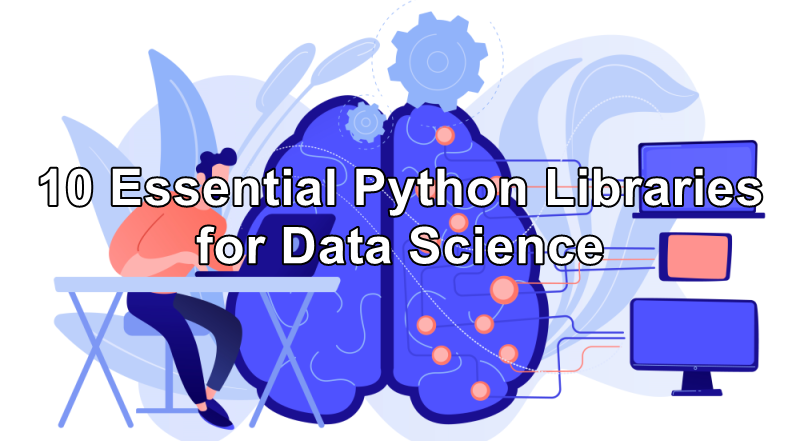Introduction:
Data Science is a multidisciplinary field that utilizes various tools and techniques to extract valuable insights and knowledge from data. Python has emerged as one of the most popular programming languages for data science due to its versatility, simplicity, and vast array of libraries. These libraries provide data scientists with powerful tools to manipulate, analyze, visualize, and model data efficiently. In this article, we will explore 10 essential Python libraries for data science that every aspiring data scientist should be familiar with. Whether you are a beginner or an experienced practitioner, these libraries will undoubtedly boost your productivity and help you tackle complex data-related challenges.

10 Essential Python Libraries for Data Science
NumPy: The Foundation of Data Science
NumPy is the fundamental library for numerical computing in Python. It provides support for large, multi-dimensional arrays and matrices, along with a collection of high-level mathematical functions to operate on these arrays. NumPy's efficient array operations and broadcasting capabilities make it a powerful tool for data manipulation and computation.
Pandas: Data Manipulation Made Easy
Pandas is a widely-used Python library for data manipulation and analysis. It introduces two essential data structures, Series and DataFrame, which enable intuitive data handling and cleaning. With Pandas, you can perform tasks such as data filtering, aggregation, merging, and transformation effortlessly.
Matplotlib: Creating Informative Visualizations
Matplotlib is a versatile library for data visualization in Python. It offers a wide range of plotting options and customization features, allowing data scientists to create informative and visually appealing charts, graphs, and plots. Matplotlib integrates well with other data science libraries, making it a crucial tool for data exploration and communication.
Seaborn: Enhancing Matplotlib Visualizations
Seaborn is a high-level visualization library built on top of Matplotlib. It simplifies the process of creating complex statistical visualizations by providing several easy-to-use functions. Seaborn excels in producing attractive and insightful statistical plots, such as scatter plots, box plots, and heatmaps.
Scikit-learn: Your Swiss Army Knife for Machine Learning
Scikit-learn is a comprehensive machine-learning library in Python. It offers a wide range of algorithms for classification, regression, clustering, and more. Scikit-learn also provides tools for data preprocessing, model evaluation, and hyperparameter tuning, making it a go-to library for implementing machine learning models.
TensorFlow: Deep Learning Made Accessible
TensorFlow is an open-source deep learning framework developed by Google. With its intuitive computational graph paradigm, TensorFlow simplifies the process of building complex neural networks. Whether you are a beginner or an expert in deep learning, TensorFlow provides the flexibility and power to develop cutting-edge models for various tasks.
Keras: High-Level Deep Learning API
Keras is an easy-to-use, high-level neural networks API that runs on top of TensorFlow. It allows data scientists to quickly prototype and experiment with different neural network architectures. Keras's user-friendly interface and extensive documentation make it an excellent choice for both beginners and experienced deep-learning practitioners.
Statsmodels: Statistical Analysis Made Simple Statsmodels is a Python library for statistical modeling and hypothesis testing. It provides a comprehensive set of tools for estimating and analyzing various statistical models, including linear regression, time series analysis, and ANOVA. For data scientists working on statistical problems, Statsmodels is an indispensable library.
NLTK: Natural Language Processing in Python NLTK (Natural Language Toolkit) is a powerful library for natural language processing (NLP) tasks. It offers various tools for tokenization, stemming, part-of-speech tagging, and more. NLTK's extensive collection of corpora and pre-trained models make it a valuable resource for text mining, sentiment analysis, and language understanding.
NetworkX: Analyzing and Visualizing Graphs
NetworkX is a Python library for the creation, manipulation, and study of the structure, dynamics, and functions of complex networks. It provides tools for graph theory, including algorithms for centrality, community detection, and pathfinding. NetworkX is widely used in diverse domains, such as social network analysis, transportation networks, and biological networks.
Conclusion:
In the world of data science, Python has become the language of choice due to its extensive library ecosystem. In this article, we explored 10 essential Python libraries that are indispensable for data scientists. From fundamental libraries like NumPy and Pandas for data manipulation to visualization libraries like Matplotlib and Seaborn for creating insightful plots, these libraries cover a wide range of data-related tasks.
Additionally, we discussed machine learning libraries like Scikit-learn and TensorFlow for building predictive models and deep learning architectures. Furthermore, Statsmodels, NLTK, and NetworkX provide valuable tools for statistical analysis, natural language processing, and graph analysis, respectively. By mastering these libraries, data scientists can efficiently tackle complex data challenges and derive meaningful insights from vast amounts of information.



Comments (0)